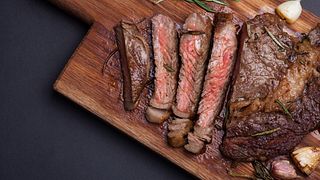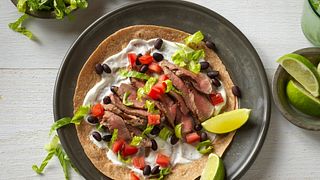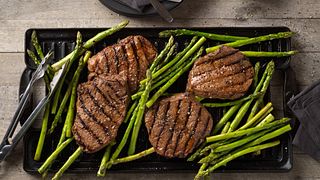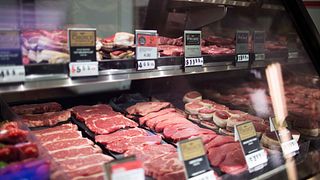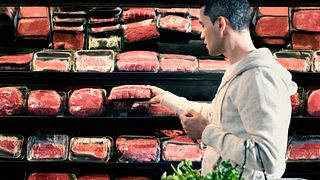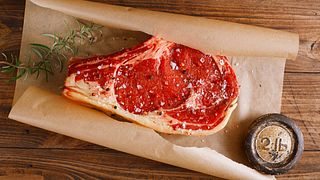Love Beef Tender: How Aging Affects Beef’s Tenderness
Tenderness is one of the biggest influencers of consumer approval of beef. Since most consumers can differentiate between tough and tender beef, improving tenderness is a high priority for the beef industry. One of the best methods to do this is by aging beef. According to aging standards, muscles should age for a minimum of 14 days for optimal effect. The majority of aging in the industry exceeds this minimum standard, with average aging times at foodservice and retail at 31.5 and 25.9 days, respectively1. Currently, aging combined with other product quality improvements such as rising USDA quality grades (aka, more marbling) the use of electrical stimulation in processing plants and greater implementation of branded programs have resulted in all-time high levels of beef tenderness across all sectors of the supply chain. Understanding the science behind aging allows retailers, foodservice operators and chefs to have more informed conversations when purchasing beef.
Aging of meat is a natural process that occurs when meat is stored under controlled refrigerated conditions. This process is used to affect traits that influence consumer satisfaction, including tenderness and flavor. Different cuts and sometimes different USDA quality grades of the same cut require different aging durations to fully capitalize on tenderness improvements.
Measuring Beef Tenderness
Scientists use two methods to measure beef tenderness. The first method is Warner-Bratzler shear force (WBSF), which assesses tenderness by measuring the amount of force in kilograms necessary to shear multiple one-half-inch core steak samples following cooking and cooling2. The second option is the Slice Shear Force (SSF) method, which measures the force, same as WBSF, of a 1-cm thick, 5-cm long slice from a steak immediately following cooking3. For both methods the higher the shear force value the tougher the meat. The use of WBSF is seen in the research sector, while SSF has been more widely used in industry applications.
It’s important to understand the impact of shear force values on the eating quality of a product. Using shear force values, you can predict the likelihood a consumer will find the tenderness of a cut acceptable. For example, consumers found that the tenderness of a Strip Steak was acceptable 50% of the time when the shear force value was 4.4 kg, however they also found that at a shear force value of 3.7 kg, 68% of the time the tenderness was acceptable. By decreasing the shear force value by only 0.7 kg, there was an 18% increase in acceptability. These values are helpful to establish optimal endpoints for different beef cuts2.
Aging Considerations
Aging beef is not a one-size-fits-all proposition. Optimal aging time varies from cut to cut and amongst different USDA quality grade and is established by determining the amount of time needed to complete the aging response to reach the target WBSF value. Knowledge of initial tenderness, the established aging response, and the rate of tenderization is necessary to determine the aging time required for a beef cut to reach the target tenderness level.
Initial tenderness is classified as tenderness before aging, which varies amongst muscles and between quality grades. Even within the same subprimal such as a Chuck Roll or Shoulder Clod, individual muscles (or finished cuts) differ in initial tenderness. Understanding aging response for individual cuts and across quality grades is also essential. The aging response is the overall change in shear force values that can occur for various cuts. Lastly, the rate of tenderization characterizes the speed at which improvement in shear force is made. When developing postmortem aging periods, all the above factors must be considered2.
Utilizing this approach, researchers at Colorado State University developed guidelines for aging specific cuts. Across all cuts, Select muscles tend to show a more rapid aging response than Choice muscles, which means that the shear force value improvement from day 2 to day 28 is greater in Select muscles. Since Select muscles tend to begin with a higher value than Upper 2/3 Choice muscles (Figure 1), they typically require a longer aging duration to achieve the same tenderness as their Choice counterparts2.
Beef Loin Aging
A Select Striploin completes over 90% of its aging response between days 21 and 28, while the Choice Striploin reaches the target threshold of < 3.7 kg in just 10 days. By day 14, a Choice Striploin will have completed almost 95% of its aging response while, during the same time frame, a Select Striploin will have completed only 65%. Quality grade differences are also seen in the initial tenderness of this cut. A Choice Strip begins with a lower tenderness value than a Select Strip before any aging mechanisms or responses have occurred. The same trend can be seen for other muscles, such as the Tri-tip2.
While the quality grade of cuts like the Striploin and the Tri-tip affect aging response, the quality grade of other cuts, like the London Broil from the beef round, have no effect. Twenty-one days provides more than 90% of shear force improvement for both Select and Choice London Broils2.
Beef Round Aging
Muscles from the round are typically less tender on average than muscles from the loin or the chuck. Cuts with higher initial shear force values and less than 14 days of aging can result in tough beef that inhibits consumer acceptance2. Around 40% of Bottom Rounds at retail are aged less than 14 days, which is less than the minimum beef aging standard. Looking further than the aging guidelines of 14 days, cut specific aging recommends aging Bottom Rounds closer to 21 days to achieve optimal results. With Bottom Rounds being inherently tougher than other muscles that are available to consumers, it is critical to achieve the maximum aging response to help this cut have greater acceptability. Using cut specific aging allows for less valued, underutilized cuts like the Bottom Round to have a better chance of consumer acceptance than they would have with just a standard 14-day aging protocol.
Muscles from the loin and chuck follow similar aging trends. Having lower initial shear force values than a Bottom Round Steak, muscles from the loin and chuck can be aged for less time. For example, a Tri-tip aged for 14 days has a noticeable tenderness improvement compared to a similarly aged Bottom Round. For optimal response, the Tri-tip still requires more than 21 days of aging. However, with its lower initial shear force value, half of consumers would already consider the Tri-tip more tender than the Bottom Round without any aging occurring2.

Beef Aging and Flavor
In addition to affecting beef tenderness, aging can influence flavor and not always in the direction you’d assume. Beef aged for 28 days or less shows no effect on positive or negative flavors. However, diverse flavor effects can result from longer aging. Research shows beef wet-aged for more than 35 days starts to show the development of off-flavor notes like metallic, sour, oxidized, musty/earthy, and liver-like. So, while aging improves tenderness, other traits affecting beef palatability may be altered with increased aging time4.
Bottom Line
Understanding the outcomes from both targeted and overall beef aging allows retailers, foodservice operators and chefs to have more informative conversations with their beef product vendors. Minimum aging requirements are often part of overall beef product specifications set with vendors. Proper aging of beef is required to ensure a great beef experience and a strong, well-informed aging program can serve as a point of differentiation point for those merchandising and menuing the product.
Use this comprehensive chart to see optimum aging times, by quality grade, for several popular beef cuts to reach 95% aging response.
- Martinez, H. A., A. N. Arnold, J. C. Brooks, C. C. Carr, K. B. Gehring, D. B. Griffin, D. S. Hale, G. G. Mafi, D. D. Johnson, C. L. Lorenzen, R. J. Maddock, R. K. Miller, D. L. VanOverbeke, B. E. Wasser, and J. W. Savell. 2017. National Beef Tenderness Survey–2015: Palatability and Shear Force Assessments of Retail and Foodservice Beef. Meat and Muscle Biology 1:138-148. doi:10.22175/mmb2017.05.0028
- Industry Guide for Beef Aging. Available at: https://www.beefresearch.org/CMDocs/BeefResearch/Industry%20Guide%20for%20Beef%20Aging.pdf.
- Shackelford, S. D. and T. L. Wheeler. 2009. Slice Shear Force. Available at: https://www.beefresearch.org/CMDocs/BeefResearch/PE_Fact_Sheets/Slice_Shear_Force.pdf.
- Foraker, B., D. Woerner, D. Gredell, J. Legako, J. Tatum, J. Martin, R. Delmore, A. Heuberger, K. Belk. 2017. Identifying the Influence of Post-mortem Aging Length and Method on Flavor and Tenderness of Beef Strip Loins. Unpublished. Available at: https://www.beefresearch.org/CMDocs/BeefResearch/PE_Project_Summaries/FY17_Woerner_Post_Mortem_Aging.pdf.
